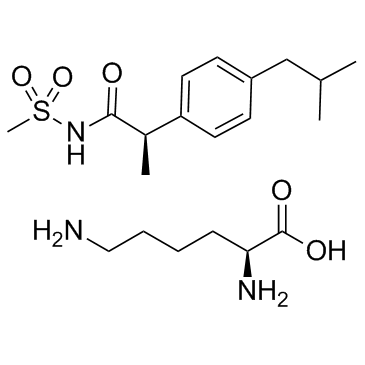Reparixin L-lysine salt
Modify Date: 2024-01-08 15:46:22

Reparixin L-lysine salt structure
|
Common Name | Reparixin L-lysine salt | ||
|---|---|---|---|---|
| CAS Number | 266359-93-7 | Molecular Weight | 429.57400 | |
| Density | N/A | Boiling Point | N/A | |
| Molecular Formula | C20H35N3O5S | Melting Point | N/A | |
| MSDS | N/A | Flash Point | N/A | |
Use of Reparixin L-lysine saltReparixin L-lysine salt is an allosteric inhibitor of chemokine receptor 1/2 (CXCR1/2) activation. |
| Name | (2S)-2,6-diaminohexanoic acid,(2R)-2-[4-(2-methylpropyl)phenyl]-N-methylsulfonylpropanamide |
|---|---|
| Synonym | More Synonyms |
| Description | Reparixin L-lysine salt is an allosteric inhibitor of chemokine receptor 1/2 (CXCR1/2) activation. |
|---|---|
| Related Catalog | |
| Target |
CXCR1wt:5.6 nM (IC50, in L1.2 cells) CXCR1Ile43Val:80 nM (IC50, in L1.2 cells) CXCR1:1 nM (IC50, in cells) CXCR2:∼100 nM (IC50, in cells) |
| In Vitro | Reparixin is a potent functional inhibitor of CXCL8-induced biological activities on human PMNs with a marked selectivity (around 400-fold) for CXCR1, as shown in specific experiments on CXCR1/L1.2 and CXCR2/L1.2 transfected cells and on human PMNs. The efficacy of Reparixin is significantly lower in L1.2 cells expressing Ile43Val CXCR1 mutant (IC50 values of 5.6 nM and 80 nM for CXCR1 wt and CXCR1 Ile43Val, respectively)[1]. Reparixin is a non-competitive allosteric inhibitor of IL-8 receptors with a 400-fold higher efficacy in inhibiting CXCR1 activity than CXCR2[2]. |
| In Vivo | The pharmacokinetics and metabolism of Reparixin are investigated in rats and dogs after intravenous administration of [14C]-Reparixin L-lysine salt. Plasma protein binding of Reparixin is >99% in the laboratory animals and humans up to 50 µg/mL, but lower at higher concentrations. Although radioactivity is rapidly distributed into rat tissues, Vss is low (about 0.15 L/kg) in both rat and dog. Nevertheless, Reparixin is more rapidly eliminated in rats (t1/2~0.5 h) than in dogs (t1/2~10 h)[3]. |
| Cell Assay | L1.2 Cell suspension (1.5-3×106 cells/mL) is incubated at 37°C for 15 min in the presence of vehicle or of Reparixin (1 nM-1 μM) and next seeded in triplicates in the upper compartment of the chemotactic chamber. Different agonists are seeded in the lower compartment of the chamber at the following concentrations: 1 nM CXCL8, 0.03 nM fMLP, 10 nM CXCL1, 2.5 nM CCL2, 30 nM C5a. The chemotactic chamber is incubated at 37°C in air with 5% CO2 for 45 min (human PMNs) or 2 h (monocytes). At the end of incubation, the filter is removed, fixed, and stained and five oil immersion fields at high magnification (100×) are counted for each migration well after sample coding. L1.2 migration is evaluated using 5 μm pore size Transwell filters[1]. |
| Animal Admin | Rats and Dogs[3] Male and female Sprague-Dawley CD (albino) rats and male Lister Hooded (partially pigmented) rats are used. Male and female beagle Dogs (age about 15 months, bodyweight range 8.3-9.4 kg at the time of dosing) are used. Rats and Dogs are dosed i.v. with repurified [14C]-Reparixin free acid and an equivalent quantity of L-lysine suitably radiodiluted with Reparixin L-lysine salt in a solution of sterile isotonic (0.9%, w/v) saline. Rats are dosed with a solution of total drug concentration 9 mg/mL at a dose volume of 5 mL/kg (30 mg free Reparixin /kg) by bolus injection into a caudal vein. Dogs are dosed with a solution of total drug concentration 100 mg/mL at a dose volume of 0.5 mL/kg (33 mg free Reparixin/kg) by bolus injection into a superficial forelimb vein. |
| References |
| Molecular Formula | C20H35N3O5S |
|---|---|
| Molecular Weight | 429.57400 |
| Exact Mass | 429.23000 |
| PSA | 164.45000 |
| LogP | 4.91340 |
| Storage condition | 2-8℃ |
| Reparixin L-lysine salt |
| Repertaxin L-lysine salt |
| CS-1380 |
| R-(-)-2-(4-Isobutylphenyl)propionyl methansulphonamide L-lysine salt |
| Reparixin (L-lysine salt) |